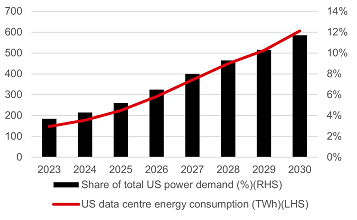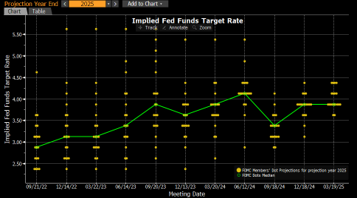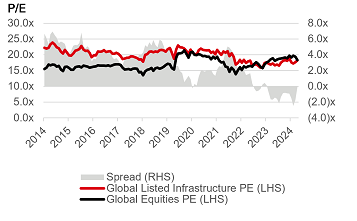Framework for a resilient future
With HSBC Infrastructure Equity Strategy
Read moreHSBC Infrastructure Equity Strategy – Capitalising on long-term themes and capturing emerging opportunities
The HSBC Infrastructure Equity strategy has a more balanced exposure to the four macro infrastructure sectors. Outside of large cap stocks, the dedicated infrastructure investment team also scours attractive opportunities in the urbanisation, energy transition and digitalisation areas. Whether you are looking to deepen your existing allocation or re-allocate to infrastructure, HSBC Infrastructure Equity strategy can offer potential opportunities.
Long-term themes

Urbanisation
|

Energy transition
|

Digitalisation
|
Short-term themes
Evolution of interest rate expectations
|
Higher power demand driven by AI and onshoring of manufacturingDemand for power for data centers is expected to rise significantly

Why it matters?
|
Global markets relative valuation
|
|
Source: HSBC AM, Bloomberg as of March 2025 |
||
Why Infrastructure Equity?
|
Inflation hedge Real assets potentially providing a natural hedge in inflationary environment |
Income Long duration assets generating potentially high distribution levels |
Liquid Liquidity providing immediate exposure to core infrastructure assets |
Defensive Defensive building block to a diversified equity portfolio |
Growth Secular growth pathway driven by a multi-decade investment cycle |
|
|
||||
Sectors we invest in
|
Communications
|
Energy infrastructure
|
Transportation
|
Utilities
|
Past performance does not predict future returns. For illustrative purposes only. This information shouldn't be considered as a recommendation to invest in the specific sectors mentioned.
The strategic advantages of Infrastructure Equity
Getting to know Infrastructure Equity
Want to know more about Infrastructure Equity as an asset class? Hear from Portfolio Manager Giuseppe Corona on the distinct benefits of our Infrastructure Equity capability and the philosophy that sets it apart.
Outlook for Infrastructure Equity sector
Discover why Infrastructure Equity can offer investors a defensive building block in the current market landscape. Joe Little, Global Chief Strategist, explores the benefits of the asset class including its lower correlation to global equities, and steady income potential.
Dislocation between price and value – Causes and implications
Since 2022, Infrastructure Equity has shown a marked dislocation between price and value. While companies have continued to deliver solid earnings and income, valuations have been muted, particularly in comparison to private infrastructure markets. Giuseppe Corona, Head of Listed Real Assets, explores the causes and implications of this divergence in our latest video.
Resources
|
Powering AI
|
Read time: |
|
|
Why invest in Infrastructure Equity
|
Read time: |
|
|
Tariffs, Taxes, Trump and Transmission
|
Read time: |
|
|
Deep-dive into Infrastructure Equity strategy
|
Read time: |
|
|
Global Infrastructure Equity – A defensive building block
|
Read time: |
Why HSBC Asset Management?
Strong experience
|
Dual research hub – London and Sydney
|
||||||||
|
Source: HSBC Asset Management as of March 2025. The investment team may change from time to time without notice. |
|||||||||
Investment team
 |
Giuseppe Corona Head of Listed Real Assets Giuseppe Corona is the Head of Listed Real Assets at HSBC Asset Management, based in the London office. He joined the financial industry in 1999 and began portfolio management across long only and long/short products in 2008. Giuseppe moved to HSBC Asset Management in March 2022, to launch its Infrastructure Equity capability. Prior to joining HSBC Asset Management, he has worked across roles covering multi-utilities and infrastructure companies, including managing long/short market neutral portfolios, a US large cap value fund and a European hedge fund. Giuseppe holds a Bachelor of Economics and Business Administration from the University of Palermo in Italy and a Master of Business Administration in International Finance from St. John's University in Italy. He is also a CFA charterholder. |
Speak with our sales team today to learn more

Dijana Gaspar
Sales Director, Active and Alternative Fund Distribution Switzerland
Tel: +41 (0)44 206 26 29
Mobile: +41 (0)79 102 49 49
Key Risks
- Equity Risk: Portfolios that invest in securities listed on a stock exchange or market could be affected by general changes in the stock market. The value of investments can go down as well as up due to equity markets movements.
- Interest Rate Risk: As interest rates rise debt securities will fall in value. The value of debt is inversely proportional to interest rate movements.
- Counterparty Risk: The possibility that the counterparty to a transaction may be unwilling or unable to meet its obligations.
- Derivatives Risk: Derivatives can behave unexpectedly. The pricing and volatility of many derivatives may diverge from strictly reflecting the pricing or volatility of their underlying reference(s), instrument or asset.
- Emerging Markets Risk: Emerging markets are less established, and often more volatile, than developed markets and involve higher risks, particularly market, liquidity and currency risks.
- Exchange Rate Risk: Changes in currency exchange rates could reduce or increase investment gains or investment losses, in some cases significantly.
- Investment Leverage Risk: Investment Leverage occurs when the economic exposure is greater than the amount invested, such as when derivatives are used. A Fund that employs leverage may experience greater gains and/or losses due to the amplification effect from a movement in the price of the reference source.
- Liquidity Risk: Liquidity Risk is the risk that a Fund may encounter difficulties meeting its obligations in respect of financial liabilities that are settled by delivering cash or other financial assets, thereby compromising existing or remaining investors.
- Operational Risk: Operational risks may subject the Fund to errors affecting transactions, valuation, accounting, and financial reporting, among other things.
- Style Risk: Different investment styles typically go in and out of favour depending on market conditions and investor sentiment.
- Model Risk: Model risk occurs when a financial model used in the portfolio management or valuation processes does not perform the tasks or capture the risks it was designed to. It is considered a subset of operational risk, as model risk mostly affects the portfolio that uses the model.
- Alternatives: Alternative investments include Private Equity, Commodities, Hedge Funds and Property. They may be difficult to sell in a timely manner or at a reasonable price. It may be difficult to obtain reliable information about their value.
- Sustainability Risk: Sustainability risk means an environmental, social or governance event or condition that, if it occurs, could cause an actual or a potential material negative impact on the value of the investment.
Important Information
For Professional Clients only and should not be distributed to or relied upon by Retail Clients.
This material/presentation/document is exclusively intended for professional investors as defined in Article 4(3)(a-g) of the Swiss Financial Services Act (FinSA, FIDLEG).
It is not intended for: professional clients who are not institutional clients under Article 4(4) FinSA and who wish to opt-in for treatment as retail clients under Article 5(5) FinSA. High-net-worth (HNW) retail clients and private investment structures created for them, who may declare themselves as professional investors (opting out).
There are further possibilities for opting-in and opting-out under FinSA. For details, please refer to our website:
https://www.assetmanagement.hsbc.ch
If you wish to change your client categorization, please inform us.
Regulatory and Documentation Notice
For HSBC GIF sub-funds that are authorized for offering in Switzerland, please refer to the list of collective investment schemes authorized for offering in Switzerland under Article 120 of the Federal Act on Collective Investment Schemes (CISA, KAG), as published by FINMA under Approved Institutes, People, and Products.
Potential investors are kindly requested to consult the latest: Key Information Document (KID), Prospectus, Articles of Incorporation, (Semi-)Annual Report of the Fund These documents can be obtained free of charge at the head office of the representative:
HSBC Global Asset Management (Switzerland) AG, Gartenstrasse 26, P.O. Box, CH-8002 Zurich. Paying Agent: HSBC Private Bank (Suisse) S.A., Quai des Bergues 9-17, P. O. Box 2888, CH-1211 Geneva
Risk Factors and Investment Warnings: Investors and potential investors must read and acknowledge the risk warnings in the Prospectus and KID. Before subscribing, investors should refer to: the Prospectus for general risk factors and the KID for specific risk factors associated with the fund. Past performance is not indicative of future results
The fund presented in this document is a sub-fund of HSBC Global Investment Funds, an investment company constituted as a société à capital variable domiciled in Luxembourg. The shares in HSBC Global Investment Funds have not been and will not be registered under the US Securities Act of 1933 and will not be sold or offered in the United States of America, its territories or possessions and all areas subject to its jurisdiction, or to United States Persons.
Past performance is no indication to future results of a fund. The performance data do not take account of the commissions and costs incurred on the issue and redemption of units.
Important information for professional investors in Liechtenstein
This information is intended exclusively for professional clients within the meaning of Annex II of Directive 2014/65/EU (MiFID II). It does not constitute an offer to the public or a solicitation to sell or market investment products into Liechtenstein. This information is provided for informational purposes only and is not intended for distribution to retail investors.






